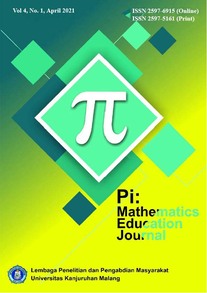STATISTICAL LITERACY OF SECONDARY SCHOOL STUDENTS IN SOLVING CONTEXTUAL PROBLEMS TAKING INTO ACCOUNT THE INITIAL STATISTICAL ABILITY
Abstract
Statistical literacy is strongly needed in the 21st century in reading data information, thinking critically and making decisions. The purpose of this study is to describe the statistical literacy abilities of high school students in solving contextual problems taking into account their initial statistical abilities, with the following indicators, Tier 1 (reading & explaining data), Tier 2 (analyzing, interpreting, interpreting critically, and making conclusions), Tier 3 (presenting data and predicting something). This research is a qualitative in nature, using statistical ability test, statistical literacy test, and interview guidelines to collect data. The subjects of this study consist of three female students of grade XII Senior High School, with high, medium and low initial statistical ability categories. The results of this study revealed that (1) The student with high initial statistical abilities can meet the indicators of Tier 1, Tier 2, Tier 3, so that she can be categorized at level 5 to 6 (critical-mathematics critical), (2) The student with medium ability can fulfil the Tier 1 indicator not fulfil the indicators in Tier 2 and Tier 3, so that it can be categorized at level 3 to 5 (Consistent noncritical-Critical), and (3) The students with low abilities can fulfill the indicators of Tier 1 not fulfil the indicators in Tier 2 and Tier 3, so that it can be categorized at level 1 to 3 (Idiosyncratic-Consistent Noncritical). Therefore, it is important for students and teachers to know statistical literacy skills in order to increase their understanding and ability to understand information in making decisions regarding daily problems.
References
Cahyawati, D., & Prabawanto, S. (2020). Eksplorasi Kemampuan Awal Statistis Mahasiswa dalam Topik Statistika Deskriptif. 2682, 201–212.
Carver, R., College, S., Everson, M., & Ohio, T. (2016). Guidelines for Assessment and Instruction Guidelines for Assessment and Instruction Guidelines for Assessment and Instruction Guidelines for Assessment and Instruction in Statistics Education (GAISE) in Statistics Education. July, 1–141. http://www.amstat.org/education/gaise.
Çatman Aksoy, E., & Işıksal Bostan, M. (2020). Seventh Graders’ Statistical Literacy: An Investigation on Bar and Line Graphs. International Journal of Science and Mathematics Education. https://doi.org/10.1007/s10763-020-10052-2
Eka, P., Nurjannah, I., & Sayoga, R. (2020). Improve the Mathematical Literacy Ability of Junior High School Students Through A. 3 (1), 43–48.
Gal, I. (2002). Adults’ Statistical Literacy: Meanings, Components, Responsibilities. International Statistical Review, 70 (1), 1–25. https://doi.org/10.1111/j.1751-5823.2002.tb00336.x
Gal, I. (2019). Understanding statistical literacy: About knowledge of contexts and models. Actas Del Tercer Congreso Internacional Virtual de Educación EstadÃstica. http://digibug.ugr.es/bitstream/handle/10481/55029/gal.pdf?sequence=1&isAllowed=y
Hafiyusholeh, M., Budayasa, K., & Siswono, T. Y. E. (2017). Literasi Statistik: Siswa SMA dalam Membaca, Menafsirkan, dan Menyimpulkan Data. Prosiding SI MaNIs (Seminar Nasional Integrasi Matematika dan Nilai Islami), 1(1), 79–85.
Mardliyah, A. A. (2018). Budaya Literasi sebagai Upaya Peningkatan Keterampilan Berpikir Kritis di Era Industri Revolusi 4.0. Jurnal Pendidikan, 2, 12–21.
NCTM. (1989). Curriculum and evaluation standard for school mathematics. the National Council of Teachers of Mathematics, Inc.
Pamungkas, A. S., & Khaerunnisa, E. (2020). The analysis of student’s statistical literacy based on prior knowledge and mathematical self -esteem. Journal for the Mathematics Education and Teaching Practices, 1(1), 43–51.
Pendidikan, K., & Jakarta, K. (2017). Panduan Gerakan Literasi Nasional.
Permendikbud. (2016). Permendikbud Nomor 24 Tentang Kompetensi Inti dan Kompetensi Dasar Tahun 2016. Kemendikbud.
Risqi, E.N. (2020). How is Statistical Literacy of Secondary School Based on Gender Differences? (p. no. 01 53-67). JRPIPM (Jurnal Riset Pendidikan dan Inovasi Pembelajaran Matematika). journal.unesa.ac.id/index.php/jrpipm
Setianingsih, R., & Rahmah, D. A. (2020). Statistical reasoning levels of high school students in solving statistics related problems. Journal of Physics: Conference Series, 1569(4). https://doi.org/10.1088/1742-6596/1569/4/042064
Sharma, S. (2017). Definitions and models of statistical literacy: a literature review. Open Review of Educational Research, 4(1), 118–133. https://doi.org/10.1080/23265507.2017.1354313
Siswono, T.Y.E. (2019). Paradigma Penelitian Pendidikan: Pengembangan Teori dan Aplikasi Pendidikan Matematika. Bandung: Remaja Rosdakarya.
Van Laar, E., van Deursen, A.J.A.M., van Dijk, J.A.G.M., & de Haan, J. (2020). Determinants of 21st-Century Skills and 21st-Century Digital Skills for Workers: A Systematic Literature Review. SAGE Open, 10 (1). https://doi.org/10.1177/2158244019900176
Watson, J. & Callingham, R. (2003). Statistical literacy: A complex hierarchical construct. Statistics Education Research Journal, 2(2), 3–46. http://www.stat.auckland.ac.nz/~iase/serj/SERJ2(2)_Watson_Callingham.pdf
Watson, J.M., & Moritz, J.B. (2000). Development of understanding of sampling for statistical literacy. Journal of Mathematical Behavior, 19(1), 109–136. https://doi.org/10.1016/S0732-3123(00)00039-0
Yuniawatika, Y. (2018). Statistical Literacy and Its Urgency for Students. 269(CoEMA), 170–173. https://doi.org/10.2991/coema-18.2018.41
Authors
Pi: Mathematics Education Journal allows readers to read, download, copy, distribute, print, search, or link to the full texts of its articles and allow readers to use them for any other lawful purpose.

This work is licensed under a Creative Commons Attribution 4.0 International License. The Authors submitting a manuscript do so with the understanding that if accepted for publication, copyright of the article shall be assigned to Pi: Mathematics Education Journal

